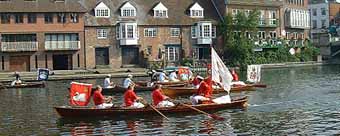![]()
![]()
ix. The Waters of Life

The cult of the swan never died out in England, it simply transformed into something new. For over 600 years, two ancient livery companies of London - the Vintners and Dyers - have accompanied the British sovereign's swan-master and swan-warden on an enchanting journey along the River Thames from London to Oxford. Its purpose is to mark and weigh all cygnets - young swans - allotted by birth-right to one or other of the companies. Great pomp and ceremony surrounds Swan-upping, as the event is known, which takes place in the third week of July (previously in association with a swan feast on St Swithin's Day, 15 July). What is more, the Vintners - the wine traders - have a whole room celebrating Swan-upping at Vintners' Hall, their home close to the River Thames in the City of London.
|
The expression 'upping' refers both to the taking up of the young birds from the water, and to the magical journey itself, which halts at the lock closest to Windsor Castle in order that the swan-master might toast the reigning sovereign as 'Seignior of the Swan'. Strangely, the whole event coincides with a major annual meteor shower called the Alpha Cygnids, where meteors are seen to come from Deneb in Cygnus, an astronomical firework display that could not have gone unnoticed. |
Swan Upping on the Thames |
Moreover, there is some evidence that the Vintners Company, derived from a 'mystery', or guild, of Saxon origin, was linked originally to the city's Roman Temple of Isis, which lay within 300 metres of Vintry Wharf, where the Swan-upping ceremony traditionally began.
Isis, the sister-wife of Osiris in Egyptian mythology, was the inventor of wine. Her symbol was traditionally the goose, although through classical associations in Roman times she became associated with the swan through her absorption of elements of the cult of Venus-Aphrodite. It is thus possible that Isis's followers in London might have honoured a pre-existing cult of the swan associated with the River Thames, where in London colonies of swans were a familiar sight right through until medieval times.
Another clue to the pagan origin of Swan-upping, and the mystery of the Vintners, is their patron St Martin of Tours. On his holy day (11 November) they performed a swan feast, during which a roasted swan was ceremoniously paraded around the banqueting room before being eagerly consumed by all present. Although this tradition continues, today the Vintners eat a goose at Martinmas, while instead of a roast swan being paraded around its place is taken by a stuffed bird. When not in use, it is kept in the Swan Room at Vintners' Hall.
Christian tradition associates St Martin with geese, although the fact that geese were also once sacrificed on his feast day across Europe argues for a much older pagan origin for this ceremonial act. Indeed, there can be little doubt that Martinmas developed as an extension of the former pagan cross-quarter day of Samhain, the Celtic new year, known also as All Soul's Day, or the Day of the Dead. It was around this time that migrating swans (and geese) returned from the Arctic, most usually at night under a full moon. Whooper swans in particular make unearthly sounds in flight that might once have been taken as the dead returning to this world, the origin perhaps of the association between Hallowe'en and the skies being alive with witches, spirits and other supernatural spectres at this time (old pictures exist showing witches riding geese in particular).
As St Martin's Day marked the arrival of migrating swans and geese, St Bride's Day on 1-2 February marked their departure, carrying the souls of the newly dead towards a northerly placed heaven among the stars of Cygnus. It is for this reason that Bride, or Bridget, became so much associated with swans and the Milky Way, for she was almost certainly a personification of the Cygnus constellation. Such information provides us with some understanding of the annual rituals that once might have taken place at prehistoric Avebury, which becomes Britain's premier site for the cult of the swan. Yet it is across the Irish Sea in Ireland that we find what is arguably the British Isles' most significant link between Cygnus and the Neolithic world.
![]()
![]()
